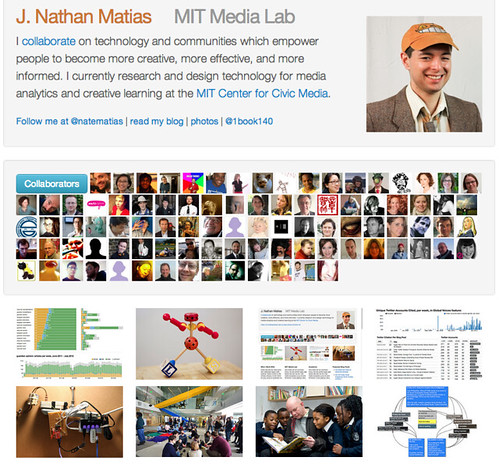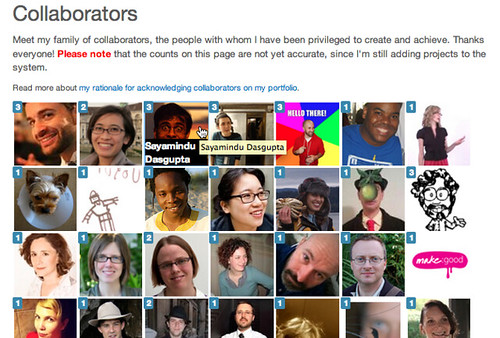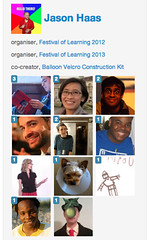Last November, I proposed that we redesign acknowledgment on the web to be more like a party and less like a duty. Promising to redesign my personal portfolio, I also promised to define an architecture that enables us to thank anyone anywhere, even in parts of the web which make acknowledgment difficult. Supervised by Mitch Resnick, and with helpful advice from many others, I have finished the alpha version of my portfolio. Here’s what I learned.
Attitudes Toward Acknowledgment
This wasn’t my decision to make alone. I have been privileged to collaborate with a wonderfully diverse set of people across business, politics, academia, software, art, and design. To learn people’s preferences across those domains, I created a prototype and sent it to nearly every one of my collaborators across the last fifteen years. Here’s what they said:
Respondents didn’t object to having their name, website url, and image on my personal portfolio. Most liked the idea of showing their Twitter or Gravatar image, though some sent a better photo. They were comfortable having their profile displayed on projects. They also appreciated the chance for oversight on how their role was presented.
Survey respondents weren’t especially interested in tracking employment. “I like the idea of acknowledging individuals instead of companies,” one said. Many wrote that employment seemed less lasting than personal collaborative realtionships. One person wrote that because people change companies so often, employment data would make relationships seem more fragmented than they are.
Most of my collaborators were excited to be displayed as part of a family of collaborators, including people they had never worked with–so long as it was clear that they have all worked with me. They were “excited to see who else” was on the list, to discover other “interesting persons” among my collaborators. One respondent commented that this would be a very honest way of presenting the nature of the work we do together. Another respondent, while comfortable with this, worried that people might try to “leverage implied relationships even where it doesn’t provide value.”
As you might imagine, it took a long time to email all my collaborators. I’m still responding to everyone. There are also a number of sensitive projects I’m still deciding on how to share, so do email me if I have left you out.
The Visual Display Of Cooperative Acknowledgement
As promised, I have redesigned my personal portfolio. Here’s what the alpha version looks like:
The most important change isn’t visual. My personal statement now acknowledges collaboration. It used to say “I make technology and communities….” I changed the word “make” to “collaborate,” with a link to my family of collaborators.
My portfolio shows a grid of collaborators at the top of my homepage. If you click on the “collaborators” button or the word “collaborate” in my personal statement, you can also view a larger page which shows the names of my collaborators and how many projects we have worked on together.
In the full version of my acknowledgment platform, it will be possible to embed large and small collaborator grids like this into your own website.
My portfolio website handles links to specific projects in two ways. If the project or blog post doesn’t exist in my portfolio, the reader is automatically redirected to that project’s home on the web. Otherwise, project pages like this one automatically show the people and organisations involved in the project:
Differentiation and Aggregation
The Ministry of Stories listing illustrates one of the basic challenges of differentiating people’s roles, especially where I’m not the primary person behind a project, where I played a smaller role than others. It isn’t a list of everyone who worked in the Ministry of Stories. It’s not even a list of everyone I collaborated with (I still need to track down and contact a few people). But it definitely is a list of my closest collaborators. Where things are complicated, I add a sentence to the project page: “I couldn’t possibly acknowledge the vast number of amazing people who worked with us on this project, of which I was just one part.”
My portfolio also aggregates people’s names and faces, sometimes showing combinations of people who have never met. To clarify and acknowledge a person’s overall contributions, I created a collaborator profile popup. When you click on a person’s picture anywhere in the site, this is what you see ===>
The Politics of Making Faces Visible
Making faces visible reveals more than the specific identities of my collaborative family. As Judith Donath points out in her 2001 paper on Mediated Faces (pdf), I’m also revealing information about the age, race, and gender of my collaborative relationships, insofar as my collaborators choose to represent themselves that way publicly.
The Acknowledger is helping me track and set personal goals in an area I hadn’t considered before: the diversity of who I collaborate with. This is especially important as I do more to mentor and support students. I recently classified my collaborators by gender and was pleased to discover that 40.6% of my collaborators are women, substantially higher than percentages within journalism or computer science. My record is not so good when it comes to other measures of diversity.
Why should be attentive to the diversity of my collaborators? Whenever anyone works together, we influence each others’ reputations and further opportunities. I love cooperating across difference because I learn from it, it makes projects stronger, and it expands my own network. Looking at the matrix of acknowledgment, I also see how cooperation across difference has the potential to bridge across structural inequalities, at least in small ways.
The Social Practice of Acknowledgment
Each profession has its own norms of acknowledmgent, and relationships differ even within the same team. After talking with my family of collaborators, it’s clear that my acknowledgment platform needs to be flexible enough to facilitate many kinds of conversations around thanks, attribution, and credit. Fair, flexible communication will need to be available to users as they work out their own agreements.
Research on collaboration and acknowledgment is more focused, because it usually makes two assumptions which aren’t true for my acknowledgment system: that collaboration can be tracked, and that collaboration occurs in a single community. I have already written about tracking in my first post, where I point out that tracking systems often leave people out. The issue of community is one that I hadn’t considered before.
Much of the current research on attribution is about platforms like Scratch, Wikipedia, or Newgrounds, where the entire user base of the site is an online community with a small number of common norms. Luther, Diakopoulos and Bruckman’s work on “Edits and Credits” is a great example of this kind of research. NewGrounds users all work on Flash games and they view each others’ work for inspiration. They also keep an eye on who gets credit for projects and want to recognise the diversity of actions that people take to create games together (slideshare pdf). Attribution can also be a major point of friction for people, as Jennifer Thom discusses in her work on Territoriality in Collaborative Authoring (pdf).
As I imagine it, my acknowledgment platform will not create one big community of all its users. It will not track users’ creative activity. Instead, I plan to encourage people to find their own ways to thank each other. Since I expect it to be used by people from very different creative worlds, I am building a system that people adapt to their unique situations– a technology which “becomes part of nature rather than controls it,” to quote Joi.
Architectures With Distributed Facades
My acknowledgment system is part of a new breed of software architectures with distributed facades. It draws from APIs, involves that information in a social process, and then shares that information to other parts of the web. Gravatar and Storify are great examples of this architecture. Gravatar is a simple service which hosts your picture and allows third party services to use that single image. Change your photo once, and your photo changes everywhere else. Lots of sites don’t make it easy to clip and share media from elsewhere, so Storify offers a simple editor for clipping together a story from different parts of the web. When you’re done, you embed the story from Storify into your own site.
Distributed facades make it easy for people to extend their current web experience with new values and features. If our online social and publishing platforms become more entrenched, distributed facades will become the shortest path to innovation, since they don’t require anyone to switch services. Even better, they knit together parts of the web that don’t naturally talk. Your portfolio might be on WordPress. My resume might be in Drupal, or just one big HTML file. With the acknowledgment system I’m building, we can work together to link up disconnected web platforms simply by offering each other acknowledgment and thanks.
The Web of APIs
My acknowledgment system also participates in the least well understood network online, what I call The Web of APIs. Although we know a lot about the infrastructure of the Internet, the social web, and the web of links, much less is known about the machine-to-machine conversations that connect our web experience.
My upcoming acknowledgment software will participate in this web every time you look at a picture, every time you look at an embedded acknowledgment, and every time it notifies you via Twitter or Facebook that someone wants to thank you. Each of those actions requires more than one part of the web to work together, either by sending data between servers or by piecing together a page in your web browser. Most web pages do this all the time; a single page can include data and content from dozens of different domains.
I hope to write more about the Web of APIs in future posts, where I will talk about my enthusiasm for services like IFTTT and ScraperWiki. I’ll also share concerns I have about advertising and personal tracking, highlighted so well by Mozilla Collusion. Overall, I think the Web of APIs is a good thing. It supports transparency and allows us to participate in a social neighbourhood while talking to people outside our ordinary online neighbourhoods. The Web of APIs might also be one of the best ways to critique and extend the values of the platforms we’re already stuck with.
Next Steps
What you have seen here are screenshots from an alpha version of the acknowledgment platform, which is currently running my experimental portfolio site . I now know exactly how the beta version will work. Unfortunately, I have a Master’s thesis to finish, and this isn’t it. Although I have purchased a domain and am very excited to share the project more broadly, I won’t have time to pick it up again until the summer.
If you have questions or ideas, please add them in the comments.







